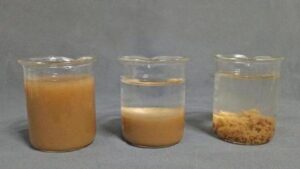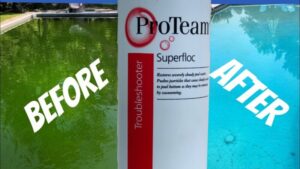Having a pool is a wonderful luxury, but it comes with the responsibility of proper maintenance. One of the most crucial aspects of pool care is ensuring that the water remains clear, inviting, and free from impurities. This blog post aims to guide you through the process of using flocculant to achieve crystal clear pool water. Whether you have a sand filter or are new to the concept of flocculation, this comprehensive guide will equip you with the knowledge and skills to floc your pool effectively without any hassle.
- What is Flocculant?
- Prerequisites for Flocking a Pool with a Sand Filter
- Steps to Flock a Pool with Flocculant
- Step 1: Determine the Right Amount of Flocculant to Add
- Step 2: Preparing the Flocculant Solution
- Step 3: Distributing the Flocculant into the Pool
- Step 4: Shutting down the Pool Filtration System
- Step 5: Allowing the Flocculant to Settle
- Step 6: Vacuuming the Sediment
- Step 7: Backwashing the Filter and Finalizing the Process
- Frequently Asked Questions
- Conclusion:
What is Flocculant?
Flocculant, also known as pool flock, is a chemical compound specifically designed to clarify pool water. The primary function of flocculant is to coagulate and bind together microscopic particles, such as dirt, debris, and algae, that may cause cloudiness in your pool water. By treating your pool water with flocculant, you can quickly transform a murky pool into a sparkling oasis.
There are two main types of flocculant: liquid and powder. Liquid flocculant is pre-diluted and ready to use, while powder flocculant requires proper mixing before it can be added to the pool water. Depending on your preference and the specific requirements of your pool, you can choose the most suitable type of flocculant.
Prerequisites for Flocking a Pool with a Sand Filter
Before diving into the process of pooling flocking, it’s crucial to ensure that certain prerequisites are met. If your pool is equipped with a sand filter, it plays a vital role in the effectiveness of flocking. Additionally, maintaining proper pH levels and performing regular pool maintenance are essential for the success of the flocking process.
Firstly, the sand filter in your pool is responsible for trapping and removing debris, contaminants, and small particles from the water. Ensure that your sand filter is clean, functional, and capable of filtering efficiently. If the sand in your filter is old or worn out, replacing it will optimize the flocking process.
Secondly, check and adjust the pH levels of your pool before floculating. The ideal pH range for optimal flocking results is between 7.2 and 7.6. Use a reliable pool water testing kit to measure the pH and adjust it accordingly using appropriate pH balancing chemicals.
Lastly, it’s crucial to maintain your pool regularly by skimming the surface, removing debris, and vacuuming. A clean pool not only improves the effectiveness of flocking but also enhances overall water quality and clarity.
By ensuring these prerequisites are met, you lay the foundation for successful flocking and enjoy the best possible results.
Steps to Flock a Pool with Flocculant
Now that you understand the basics and the prerequisites, let’s dive into the step-by-step process of flocking your pool with flocculant. Following these steps meticulously will help you achieve the desired clarity and cleanliness for your pool water.
Step 1: Determine the Right Amount of Flocculant to Add
The first step in flocking your pool is determining the correct amount of flocculant to add. The recommended dosage of flocculant varies based on the size of your pool and the flocculant manufacturer’s instructions. Generally, one ounce of flocculant is sufficient for every 5,000 gallons of pool water.
To calculate the exact amount of flocculant required, you need to determine the volume of water in your pool. This can be done by multiplying the pool’s length, width, and average depth. For example, if your pool measures 20 feet in length, 12 feet in width, and has an average depth of 5 feet, the volume would be 20 x 12 x 5 = 1,200 cubic feet. Convert this to gallons by multiplying it by 7.48, which brings the total volume to 8,976 gallons.
Once you have the volume of your pool, refer to the flocculant manufacturer’s guidelines to calculate the appropriate amount of flocculant needed. Remember to follow the instructions provided, as different brands might have varying concentrations.
Step 2: Preparing the Flocculant Solution
Now that you know the amount of flocculant required, it’s time to prepare the solution. Depending on the type of flocculant you have chosen, follow the instructions for dilution.
If using liquid flocculant, it is typically pre-diluted and ready for use. Shake the bottle well to ensure even distribution of the flocculant within the liquid. If any settlement has occurred, gently mix it until the solution appears homogeneous.
For powder flocculant, dissolve the recommended amount of flocculant in a clean bucket of warm water. Stir the mixture until the powder is fully dissolved. Take caution not to inhale the fumes or directly handle the flocculant without proper protective gear.
Step 3: Distributing the Flocculant into the Pool
Ensure that all pool equipment, such as pumps and filters, are running before adding the flocculant solution. Slowly pour the diluted flocculant into the pool while moving around the perimeter. Distribute the flocculant solution evenly to promote a consistent reaction throughout the water.
To aid in the even dispersion of the flocculant, you can use a pool brush or a pool water return jet. Brushing the walls and floor of the pool while the flocculant is added will help disperse and mix it effectively.
Step 4: Shutting down the Pool Filtration System
After distributing the flocculant into the pool, it’s important to turn off the pool filtration system. The goal is to allow the flocculant to settle and work its magic without being disturbed by the filtration process.
Switch off the pool pump and filter system, ensuring it remains off for the required settling time. Note that the recommended settling time varies for different flocculant brands and pool sizes. Generally, it can take anywhere from 12 to 24 hours. Refer to the manufacturer’s instructions for the specific settling time for your chosen flocculant.
Step 5: Allowing the Flocculant to Settle

During the settling period, the flocculant takes action by attracting and clumping together the suspended particles in the water. These clumps, also known as floc, increase in size and become heavy, ultimately sinking to the bottom of the pool. As the floc settles, it carries the impurities and cloudiness with it, leaving the water crystal clear.just click here if you are thinking about Can Too Much Chlorine Cause Cloudy Pool Water? Exploring the Effects and Solutions
Be patient during this process and resist the temptation to turn on the filtration system prematurely. The longer the settling period, the better the results are likely to be.
Step 6: Vacuuming the Sediment
Once the settling period is complete, it’s time to remove the sediment or floc from the bottom of the pool. Begin by attaching a vacuum head to your pool skimmer or vacuuming port, ensuring a tight connection to prevent the loss of suction.
Gently vacuum the sedimented floc from the bottom of the pool, working slowly and methodically. Pay attention to corners, steps, and other areas where debris might accumulate. Work your way around the pool until all the floc and sediment have been effectively removed.
After vacuuming, it’s recommended to run the pool water through a pool filter capable of fine filtration to capture any remaining particles. Keep in mind that the filter may need cleaning or backwashing frequently during and after this process to maintain its efficiency.
Step 7: Backwashing the Filter and Finalizing the Process
Finally, it’s time to perform routine maintenance on your pool filter to ensure optimum performance. Backwashing the filter will help remove any trapped particles and debris collected during the flocking process.
Refer to your filter’s user manual for specific backwashing instructions. Typically, you need to turn off the pump, set the filter valve to the “backwash” position, and then turn the pump back on. Allow the water to flow backward through the filter, flushing out the accumulated debris. Continue the backwashing process until the water appears clear and free from cloudiness.
After backwashing, reset the filter to its regular operating position, typically labeled as “Filter” or “Normal.” Restart the filtration system and let it run normally. Monitor the water’s clarity and adjust the pool chemistry, if required, to maintain optimal conditions.
Now that you have successfully flocked your pool with flocculant, enjoy the clear and sparkling water it provides.
Frequently Asked Questions
How often should I flock my pool?
The frequency of flocking your pool depends on various factors, such as the pool’s usage, the surrounding environment, and the water quality you desire. For most pool owners, flocking is done as a part of the regular pool maintenance routine or when the water starts to appear cloudy or dull. It’s generally recommended to flock the pool at least once or twice a pool season.
Can I run flocculant through the pool filter?
Flocculant is designed to be used without running it through the pool filter. Its purpose is to precipitate suspended particles and impurities in the water, causing them to settle to the bottom of the pool. Running flocculant through the filter may disrupt the flocking process and decrease its effectiveness. However, after the flocking process is complete, it is necessary to run the pool water through the pool filter to capture any remaining debris before resuming normal filtration operations.
What are the risks or side effects of using flocculant?
When used according to the manufacturer’s instructions, flocculant is generally safe and highly effective. However, it’s crucial to handle flocculant with care and wear appropriate protective gear, such as gloves and goggles, as some individuals may experience mild skin or eye irritation with direct contact. Additionally, avoid ingestion or inhalation of the flocculant to prevent any potential health risks.
Can I still use the pool while the flocculant is settling?
It is recommended to avoid using the pool while the flocculant is settling and doing its job. Interrupting the settling process by swimming, splashing, or running the pool equipment can disturb the flocculant and hinder its effectiveness. Once the flocculant has settled, and the sediment has been vacuumed and removed, you can resume normal pool usage after ensuring that the water chemistry is balanced.
Conclusion:
Achieving crystal clear pool water is within reach for every pool owner, courtesy of the powerful tool known as flocculant. By following the step-by-step guide outlined in this blog post, you can confidently flock your pool and transform cloudy water into a sparkling oasis.
Remember to check the prerequisites before starting the flocking process, including the functionality of your sand filter, maintaining optimal pH levels, and regular pool maintenance. Calculate the correct amount of flocculant based on your pool size and dilute it according to the manufacturer’s instructions.
Distribute the flocculant evenly across the pool surface and allow it to settle undisturbed for the recommended time. Vacuum the settled floc from the bottom of the pool, paying attention to all areas, and backwash the filter to remove any remaining debris.
By adhering to these steps and guidelines, you can enjoy the benefits of crystal clear water and create a safe and inviting environment for swimming and relaxation. For further pool maintenance tips and information, explore our blog and stay tuned for more expert advice.
Remember, maintaining a clean and healthy pool is an ongoing process, and taking care of it regularly will ensure that it remains a source of joy and relaxation for you and your family all year round.
Make a splash with sparkling pool water – floc your pool today!

Greetings, fellow pool enthusiasts! I’m Turner Davis, your dedicated guide to the world of pool care and maintenance. With over a decade of experience in the field, I’ve made it my mission to transform ordinary pools into extraordinary aquatic retreats.

